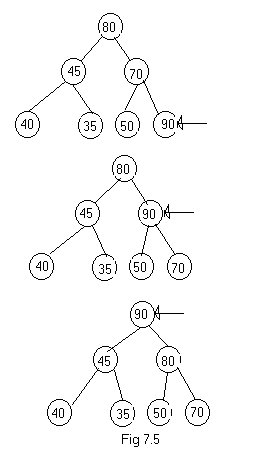
 Active Topics
Active Topics  Memberlist
Memberlist  Calendar
Calendar  Search
Search  |
 Active Topics Active Topics  Memberlist Memberlist  Calendar Calendar  Search Search |
| |
| |
  |
| Author | Message |
|
gita
Newbie 
Joined: 08Apr2007 Online Status: Offline Posts: 19 |
  Topic: Heaps and Heap Sort Topic: Heaps and Heap SortPosted: 08Apr2007 at 11:24pm |
|
7.4 Heaps and Heap sort:
A heap is a complete binary tree with the property that the value at each node is atleast as large as the value at its children.
The
definition of a max heap implies that one of the largest elements is at
the root of the heap. If the elements are distinct then the root
contains the largest item. A max heap can be implemented using an array
an[ ].
To
insert an element into the heap, one adds it "at the bottom" of the
heap and then compares it with its parent, grandparent, great
grandparent and so on, until it is less than or equal to one of these
values. Algorithm insert describes this process in detail.
Algorithm Insert(a,n)
{
// Insert a[n] into the heap which is stored in a[1:n-1]
I=n;
item=a[n];
while( (I>n) and (a[ I!/2 ] < item)) do
{
a = a[I/2];
I=I/2;
}
a=item;
return (true);
}
 The
figure shows one example of how insert would insert a new value into an
existing heap of five elements. It is clear from the algorithm and the
figure that the time for insert can vary. In the best case the new
elements are correctly positioned initially and no new values need to
be rearranged. In the worst case the number of executions of the while
loop is proportional to the number of levels in the heap. Thus if there
are n elements in the heap, inserting new elements takes O(log n) time
in the worst case.
To
delete the maximum key from the max heap, we use an algorithm called
Adjust. Adjust takes as input the array a[ ] and integer I and n. It
regards a[1..n] as a complete binary tree. If the subtrees rooted at 2I
and 2I+1 are max heaps, then adjust will rearrange elements of a[ ]
such that the tree
rooted at I is also a max heap. The maximum elements from the max heap
a[1..n] can be deleted by deleting the root of the corresponding
complete binary tree. The last element of the array, i.e. a[n], is
copied to the root, and finally we call Adjust(a,1,n-1).
Algorithm Adjust(a,I,n)
{
j=2I;
item=a;
while (j<=n) do
{
if ((j<=n) and (a[j]< a[j+1])) then
j=j+1;
The
figure shows one example of how insert would insert a new value into an
existing heap of five elements. It is clear from the algorithm and the
figure that the time for insert can vary. In the best case the new
elements are correctly positioned initially and no new values need to
be rearranged. In the worst case the number of executions of the while
loop is proportional to the number of levels in the heap. Thus if there
are n elements in the heap, inserting new elements takes O(log n) time
in the worst case.
To
delete the maximum key from the max heap, we use an algorithm called
Adjust. Adjust takes as input the array a[ ] and integer I and n. It
regards a[1..n] as a complete binary tree. If the subtrees rooted at 2I
and 2I+1 are max heaps, then adjust will rearrange elements of a[ ]
such that the tree
rooted at I is also a max heap. The maximum elements from the max heap
a[1..n] can be deleted by deleting the root of the corresponding
complete binary tree. The last element of the array, i.e. a[n], is
copied to the root, and finally we call Adjust(a,1,n-1).
Algorithm Adjust(a,I,n)
{
j=2I;
item=a;
while (j<=n) do
{
if ((j<=n) and (a[j]< a[j+1])) then
j=j+1;
Post Resume: Click here to Upload your Resume & Apply for Jobs |
|
 IP Logged IP Logged |
|
  |
||
Forum Jump |
You cannot post new topics in this forum You cannot reply to topics in this forum You cannot delete your posts in this forum You cannot edit your posts in this forum You cannot create polls in this forum You cannot vote in polls in this forum |
|
|

© Vyom Technosoft Pvt. Ltd. All Rights Reserved.